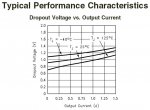...don't know if this has been posted before or not...
A while back I needed a driver that could function with a lower supply voltage. I'm a big fan of DDL's and derivatives of same.
It turns out that the LM317 has at least one sister: the LM1086. See www.national.com for more info.
The 1086 is nearly identical to the 317, except that it has only a 1 to 1.5v dropout (the lower the current, the lower its dropout voltage).
The reference voltage is still 1.25, and the chip is otherwise pretty much identical to the 317.
So if you build a DDL circuit with the 1086, you can have lasers that operate on lower supply voltages.
Example: If your supply is three AA NimH batteries in series, or two or three 14500 batteries in parallel, your power source is 3.6 nominal (4.1 peak).
For a laser operating at ~250mA and ~2v, a 1086 driver circuit will reduce that voltage from 3.6 to 2.6 (the 1086 dropout is only ~1v at this current level). The 1N4001 diode will reportedly take another 0.7 volt, leaving you at ~1.9. The current will be whatever you establish with the resistors.
If this has already been posted, sorry for the repeat!
A while back I needed a driver that could function with a lower supply voltage. I'm a big fan of DDL's and derivatives of same.
It turns out that the LM317 has at least one sister: the LM1086. See www.national.com for more info.
The 1086 is nearly identical to the 317, except that it has only a 1 to 1.5v dropout (the lower the current, the lower its dropout voltage).
The reference voltage is still 1.25, and the chip is otherwise pretty much identical to the 317.
So if you build a DDL circuit with the 1086, you can have lasers that operate on lower supply voltages.
Example: If your supply is three AA NimH batteries in series, or two or three 14500 batteries in parallel, your power source is 3.6 nominal (4.1 peak).
For a laser operating at ~250mA and ~2v, a 1086 driver circuit will reduce that voltage from 3.6 to 2.6 (the 1086 dropout is only ~1v at this current level). The 1N4001 diode will reportedly take another 0.7 volt, leaving you at ~1.9. The current will be whatever you establish with the resistors.
If this has already been posted, sorry for the repeat!





